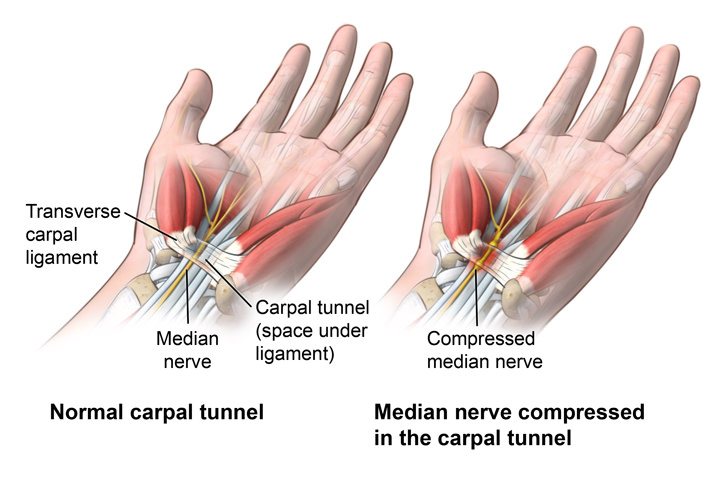Carpal tunnel syndrome or CTS is a collection of signs and symptoms in the hand due to compression of one of the nerves travelling into the hand from the forearm. Carpal tunnel symptoms can include pain, numbness and pins and needles in the areas of the hand supplied by the affected nerve. Loss of strength and feeling in the hand may also be present.
Carpal Tunnel Syndrome Cause
The median nerve passes into the hand almost in the centre of the wrist on the palm side. At that point it is surrounded by firm structures that don’t have any give. If pressure increases in that area the nerve’s ability to transmit impulses normally can be affected and this leads to the symptoms.
The nerve can lose its insulating myelin sheath which allows it to conduct messages quickly and individual nerve fibres can also die back. The nerve fibres that control feeling are usually the first to be affected with the motor (muscle controlling) nerves next. There may also be changes in the circulation and warmth of the hand as autonomic nerve fibres are compressed.
Many factors may be connected to developing CTS and they can include increasing age, increased body weight, being female, pregnancy and breastfeeding, various medical disorders, a wrist fracture and jobs involving repetitive and forceful wrist movements. Definite causing factors are often not clear.
Who Gets Carpal Tunnel?
Women get CTS at a rate of 3 to 10 times that of men and the main age range if from 45 to 60 years. It’s rare in younger people. If untreated the median nerve can be damaged and hand function significantly reduced. It is more common in white people, diabetics, people with thyroid problems, after wrist fracture or injury, RA, in activities with vibration and in pregnancy and breastfeeding periods.
Carpal Tunnel Tests
Blood tests are not useful for CTS, unless the doctor is looking for other conditions that might be relevant, such as diabetes or thyroid problems. MRI scanning and ultrasound are used but the most useful test is electrophysiology. This measures how close to normal the nerve transmission is and can indicate the severity of the problem and help monitor any change after treatment.
Carpal Tunnel Symptoms
- Tingling and numbness. The hands may fall asleep or the person may drop things and the grip fails without noticing until too late to stop things dropping. Symptoms may be brought on by activities and may also wake the person at night. The dominant hand is typically the first to be affected although it commonly occurs in both at the same time. The symptoms are felt on the thumb side of the hand over to the ring finger.
- Pain. Aching at the wrist, pain in the palm and finger and pain up the forearm can all occur. Hand pain at night may be an early symptom.
- Autonomic symptoms can include the whole hand and it may feel swollen or be hot or cold. Sensitivity to cold can also develop.
- Loss of muscle power can occur, affecting the ability to do precise things with the thumb, but the other symptoms are usually more troublesome. Dropping things is more commonly due to the lack of precise feeling in the fingers rather than weakness of the muscles.
Carpal Tunnel Treatment
- Physiotherapy may help by prescribing a fitness regime to lose weight, ultrasound or short wave diathermy and using wrist splints for wearing at night (for at least three to four weeks). Limiting the activity of the wrist and using ice may also be useful.
- Steroid injections have proved to be beneficial if physiotherapy has failed to improve the symptoms.
- Surgical release of the transverse ligament (carpal tunnel release), which runs over the top of the nerve, does have good success rates at over 90%. In the longer term however, the rate of success after surgery may be closer to 60%.
References:
- Carpal Tunnel Syndrome. NICE. http://cks.nice.org.uk/carpal-tunnel-syndrome#!topicsummary
- Carpal tunnel syndrome. Medscape. http://emedicine.medscape.com/article/327330-overview
Last Review Date: 19-02-2020
Next Review Date: 14-02-2022

